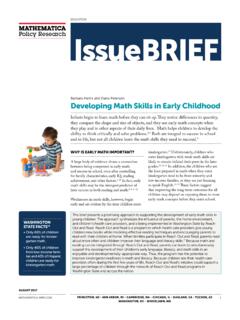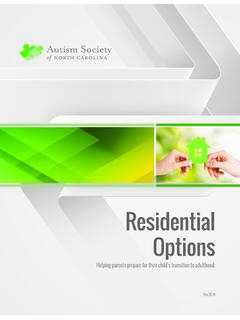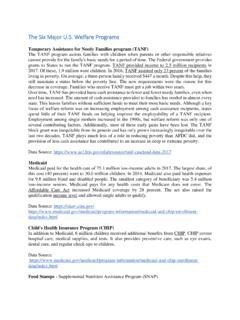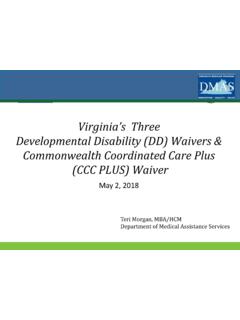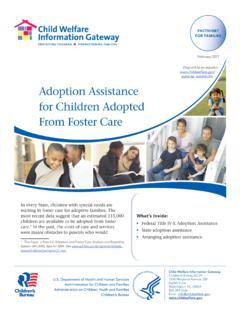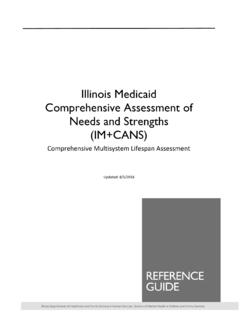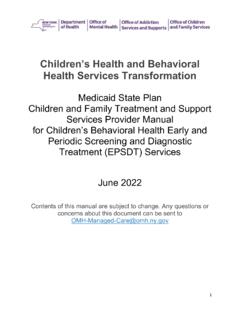Transcription of The Maternal, Infant, and Early Childhood Home Visiting ...
1 The maternal , infant , and Early Childhood home Visiting Program BACKGROUND Since 2010, HRSA s voluntary, evidence-based maternal , infant , and Early Childhood home Visiting (MIECHV) Program has empowered families with the tools they need to thrive. The MIECHV Program supports home Visiting for pregnant women and families with children up to kindergarten entry living in communities at risk for poor maternal and child health outcomes. The Program builds upon decades of scientific research showing that home visits by a nurse, social worker, Early Childhood educator, or other trained professional during pregnancy and Early Childhood improve the lives of children and families. home Visiting helps prevent child abuse and neglect, supports positive parenting, improves maternal and child health, and promotes child development and school home Visiting helps children and families get off to a better, healthier start, and it can be cost-effective in the long term, with the largest benefits coming through reduced spending on government programs and increased individual By developing strong relationships with families, providing regular home visits, assessing family needs and delivering tailored services, the MIECHV Program supports the health and well-being of pregnant women and parents with young children .
2 1 Program Administration The MIECHV Program is administered by the Health Resources and Services Administration (HRSA) in partnership with the Administration for children and Families (ACF). In February 2018, the MIECHV Program was allocated $400 million per year through fiscal year (FY) Brief published 7/2021 2022. States, territories, and tribal entities receive funding through the MIECHV Program. They have the flexibility to tailor the program to serve the specific needs of their communities. Through a needs assessment, states identify target populations and select home Visiting service delivery models that best meet state and local needs. By law, state and territory awardees must spend the majority of their MIECHV Program grants to implement evidence-based home Visiting models, with up to 25 percent of funding available to implement promising approaches that will undergo rigorous evaluation.
3 Nineteen home Visiting models meet the Department of Health and Human Services criteria for evidence of effectiveness and are eligible for state and territory MIECHV Program Three state awardees are implementing and evaluating three different promising approach models. What is home Visiting ? All home Visiting programs share characteristics; yet evidence-based models have different approaches based on family needs ( , some programs serve expecting parents while others serve families after the birth of a child). In these voluntary programs, trained professionals meet regularly with expectant parents or families with young children who want and ask for support, building strong, positive relationships. home visitors evaluate families strengths and needs and provide services tailored to those needs, such as: Teaching positive parenting skills and parent-childinteractions.
4 Promoting Early learning in the home , with an emphasison strong communication between parents and childrenthat stimulates Early language development. Providing information and guidance on a wide range oftopics, including breastfeeding, safe sleep practices,injury prevention, and nutrition. Conducting screenings and providing referrals toaddress postpartum depression, substance abuse, andfamily violence. Screening children for developmental delays andfacilitating Early diagnosis and intervention for autismand other developmental disabilities. Connecting families to other services and resources ROLE OF home Visiting DURING A PUBLIC HEALTH EMERGENCY In response to the COVID-19 public health emergency, many home Visiting programs transitioned to virtual service delivery to protect the health and safety of families and the home Visiting workforce.
5 Despite this challenge, home Visiting programs continue to play a vital role in addressing the needs of pregnant women, young children , and families. MIECHV-funded home Visiting programs quickly shifted to telephone and/or video technology to maintain contact with families and conduct visits virtually. home visitors support families by identifying local and national COVID-19 related resources, including CDC s up-to-date recommendations about the impact of COVID-19 on pregnant women, to help families understand the increased risk of severe illness. home visitors connect families to needed health, mental health, child care and other services, and work with families to identify strategies for managing stress and social isolation and promote family emergency planning strategies. The potential impacts of the emergency on pregnant women and families access to critical health, Early care and education, and family economic supports make continued connections with families through home Visiting essential.
6 The American Rescue Plan Act of 2021 appropriated $150 million for MIECHV Program awardees to continue to support children and families affected by the COVID-19 pandemic. PROGRAM PARTICIPANTS AND COMMUNITIES SERVED In FY 2020, the MIECHV Program served all 50 states, the District of Columbia, and five territories. Among the 56 awardees, states and territories served approximately 140,000 parents and children in 71,000 families, and provided over 925,000 home visits. The MIECHV Program served many of the most vulnerable families in FY 2020: 70 percent of participating families had householdincomes at or below 100 percent of the Federal Povertyguidelines ($26,200 for a family four), and 41 percentwere at or below 50 percent of those Figure 1: Counties where MIECHV Households Receive Services Rural counties Non-rural counties 62 percent of adult program participants had a high school education or less.
7 78 percent of participating adults and children relied on Medicaid or CHIP. Of all households served: 21 percent reported a history of child abuse and maltreatment. 15 percent reported substance abuse. 10 percent included pregnant teens. The MIECHV Program reached many communities in FY 2020: 1,054 counties, which is 32 percent of all counties. 41 percent of all urban counties, and 27 percent of all rural 51 percent of all counties served by the MIECHV program were rural. 3 PERFORMANCE MEASUREMENT HRSA requires MIECHV Program awardees to report performance measurement system includes a total of 19 on their program s performance related to six statutorily measures across the six benchmark defined benchmark areas (see Figure 2). The MIECHV Figure 2.
8 Benchmark Domains and Associated Performance Measures maternal and Newborn Health Preterm Birth Breastfeeding Depression Screening Well-Child Visit Postpartum Care Tobacco Cessation Referrals Child Injuries, Maltreatment, and Reduction of Emergency Department Visits Safe Sleep Child Injury Child Maltreatment School Readiness and Achievement Parent-Child Interaction Early Language and Literacy Activities Developmental Screening Behavioral Concerns Crime or Domestic Violence Intimate Partner Violence (IPV) Screening Family Economic Self-Sufficiency Primary Caregiver Education Continuity of Health Insurance Coordination and Referrals Completed Depression Referrals Completed Developmental Referrals Intimate Partner Violence (IPV) Referrals The 19 performance measures reflect the two-generation approach of the MIECHV Program, aimed at improving the well-being of both parents and children across the Below is a subset of performance outcomes that highlight the impact of the Program on parents and their children .
9 Depression Screening: Research shows that postpartum depression can be associated with a number of adverse outcomes for both the mother and infant , such as poor parent-child bonding, negative parenting approaches, and increased risk of developmental, health, and safety concerns for the ,9,10,11,12,13 Postpartum depression is also common Depression Screening 78% 81% and treatable, 14and Early screening and identification can be beneficial for the entire family. 81 percent of MIECHV caregivers were screened for depression within 3 months of enrollment or 3 months of delivery in FY 2020, as compared to a three-year average of 78 percent from 2017 to 2019. Early Language and Literacy Activities: children that are spoken to frequently by their caregivers have larger vocabulary and literacy skills, and these skills can be linked to later academic, social, and cognitive ,16 home visitors teach parents about Early Language and Literacy 69% 79% Three-Year Average FY 2020 Three-Year Average FY 2020 (2017 - 2019) (2017 - 2019) 4 the importance of these Early language and literacy activities, and help them learn skills and techniques to incorporate them into their regular routine.
10 79 percent of children enrolled in MIECHV had a family member who read, told stories, and/or sang with them on a daily basis in FY 2020, a ten percentage point increase as compared to the average of the three previous years. Safe Sleep: Approximately 3,500 infants die each year from sleep-related deaths in the United ,18 Following recommended infant safe sleep practices can reduce the risk of sudden infant death syndrome (SIDS) and other sleep-related infant ,19 home visitors help caregivers create a safe sleep environment by providing safe sleep education and engaging in family-centered conversations on safe sleep recommendations and strategies. Safe Sleep 61% 54% Three-Year Average FY 2020 (2017 - 2019) 61 percent of children enrolled in MIECHV were always placed to sleep on their backs, without bed-sharing or soft bedding in FY 2020, as compared to an average of 54 percent, from the previous three years.

